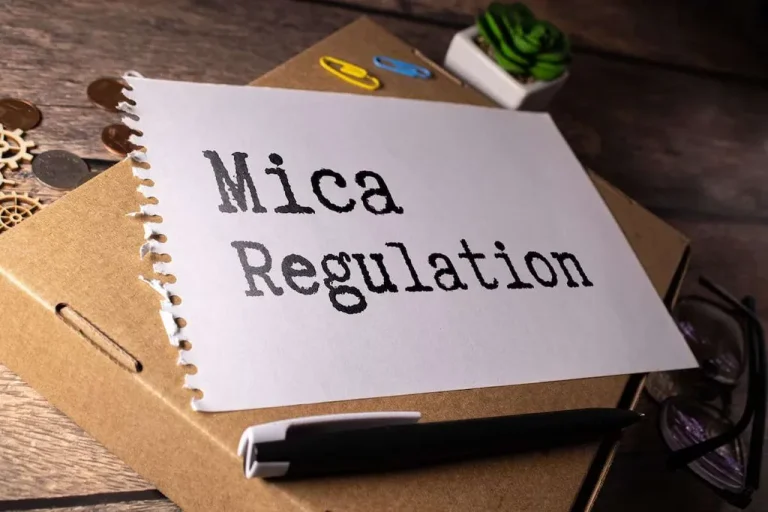The lack of widespread adoption of cryptocurrencies and limited use cases of distributed ledgers fuel major investor mistrust and contribute to high volatility. The Markets in Crypto Assets (MiCA) legislation was developed to address these issues. Improving the industry’s financial health requires establishing transparent rules for traders, exchange platforms, investors, and other market participants. The MiCA regulation, which the EU parliament approved, became an innovative solution devised to dissipate common concerns.
After the law’s swift ratification, it provides clear guidelines and helps all parties interested in decentralized assets. Regulating the provision of services related to the usage of digital tokens is expected to positively impact markets in the coming years, offering a safe framework.
History of MiCA
Attempts to control the transactions between digital asset holders started early, but they did not result in tangible improvements. MiCA crypto legislation is expected to be a simple answer to the question of whether it is safe for global stakeholders to invest in an emerging market.
Contributing to the establishment of a multi-jurisdictional space with transparent rules and clearly outlined responsibilities of a crypto asset service provider (CASP), the new laws open a pathway to continuing industry development.
After the Economic and Monetary Affairs Committee approved the blockchain-based asset regulation late in 2022, this decision was quickly followed by the European Parliament vote. The law came into force half a year later. By the end of 2024, it will be possible to enforce seven Titles. This law is expected to shape the industry’s growth and remove obstacles hindering its progress.
Now, service providers should register with national authorities to operate freely. They are expected to meet specific criteria and contribute to the market’s stability. This innovative crypto regulation designed specifically for decentralized currencies is projected to become the major cornerstone of the industry’s future growth and convince potential investors to consider the opportunities offered by the blockchain.


Turnkey Brokerage Solution For Your Business
Get the most profitable fully licensed fx/crypto brokerage software or ready-to-operate business in 48 hours. Best-in-class web & mobile trading platforms, sales-driven CRM, full integration with MT4/5, and 150+ payment providers.
ESMA Consultations
Decentralized ledger technology (DLT) opened a pathway to low-latency transactions and allowed businesses to optimize expenses and save money on transaction fees. The development of regulatory rules is a positive signal to those who still have doubts regarding DLT. The European Securities and Markets Authority (ESMA) cooperates with other regulators to address the needs of every CASP and solve the issues that worry regular traders.
ESMA analyzes the feedback provided by stakeholders and uses these insights to make further improvements. The regulatory body released three consultation packages to ensure the public is informed about the measures and can contribute to their development. The first bundle was released when MiCA became the law. The subsequent packages became available in October 2023 and March 2024.
What is Сovered by MiCA?
The law defines blockchain-based products as digital representations of value that can be transferred and stored using DLT. It also outlines differences between tokens and cryptocurrency assets and provides the rules every CASP should follow to remain compliant.
The provision of complete information about the issued products is one of the main requirements. Besides, CASPs should be registered, strictly adhere to anti-money laundering laws, and establish top-grade protection measures to secure the data.
MiCA also sets a framework regulating the activities conducted by decentralized asset issuers. The law was adopted by all EU member states. The regulators pursue several goals:
- Stabilize the market: Institutional investors are put off by high volatility. Fostering resilience is crucial to minimize risks and eliminate systemic failures.
- Protect clients: The guidelines are devised to safeguard all the stakeholders and create a predictable environment.
- Develop a legal framework: Offering universal rules for everyone to follow, MiCA makes it unnecessary to implement convoluted legislation at a local level.
- Foster innovation: Despite the widespread belief that regulators handicap development, MiCA was created to foster the industry’s growth.
The law is expected to shape the industry and help all participants to follow predictable patterns. According to its provisions, cryptocurrency issuers must take these steps:
- Publish a whitepaper: The document should contain technical specs, detailed information about a project, and possible risks. Before its release, the team behind the creation of an asset does not have the right to launch marketing campaigns.
- Maintain a reliable liquidity reserve: Every investor should be able to redeem tokens regardless of their current value.
- Implement risk management practices: In addition to establishing powerful governance practices and tracking changes in regulatory policies, issuers should meet other operational rules to protect investors.
MiCA also describes the rules obligatory for other stakeholders. By the law, CASPs should perform such tasks:
- Get approval from EU authorities
- Follow regulation updates
- Ensure liquidity
The owners of exchange platforms, digital wallets, and trading services must be authorized to operate on the market. The top providers have already taken steps to prevent unregulated stablecoin circulation.
Nevertheless, MiCA still does not provide an all-encompassing framework for the decentralized finance (DeFi) industry, as it does not control non fungible tokens (NFT). The narrow scope of the law indicates further steps must be taken to enable it to regulate the provision of blockchain services.
Security tokens also have a set of features that make them risky in the eyes of potential investors. Digital currencies issued by central banks also require extra attention. While MiCA will stabilize the environment, further legislative advancements are necessary to ensure the uninterrupted functioning of the industry.

Classification of Crypto Assets
MiCA regulation also establishes the typology of DLT-based assets. The law outlines the following categories of decentralized valuables:
- E-money tokens (EMT): Stable value is achieved due to the connection to a single fiat currency. Stablecoins are the most attractive options for businesses seeking to expand operations abroad.
- Asset-referenced tokens: Their value is linked to bundles of fiat currencies, commodities, or various combined holdings. ARTs encompass products that do not fall under the category of EMT. One of the best examples is Digix, as its liquidity is guaranteed due to the equivalent amount of gold stored securely.
- Utility tokens: These assets allow users to access DLT services offered by a specific CASP. In many countries, they cannot be considered as securities.
Focusing on these categories ensures the new law establishes a clear framework for existing assets simultaneously, contributing to the market’s stability.
Why Does MiCA Matter?
The law is expected to play a pivotal role in changing consumer mood and demonstrating to stakeholders that it is safe to invest in the booming market. Introducing powerful mechanisms guaranteeing stablecoin liquidity, MiCA diminishes risks and imposes additional protection measures to safeguard assets.
This legislation has another noticeable advantage. It regulates the environmental effects of mining. This process relies on the usage of resource-consuming equipment components. Ensuring that the mining activities do not affect nature is necessary to expedite adoption.
MiCA is the first step of a broader effort to regulate the industry. Setting service provision standards contributes to the continuing development of DLT. The definition of a financial instrument allows stakeholders to operate within a transparent framework, facilitates transactions, and ensures the stable functioning of exchanges.
MiCA’s Positive Impact on Crypto Businesses
Due to the lack of similar legislative frameworks, the adoption of this pioneering law is expected to drastically change the market. While experts are cautious when discussing the potential benefits of its implementation, the regulation will facilitate business operations across the EU and make it easier for participants to address possible challenges and preserve capital during volatility spikes. MiCA is predicted to lead to a range of beneficial developments:
- Increase the market’s attractiveness: The influx of major investors will stabilize the industry and provide the necessary liquidity. It will contribute to the market’s maturity and result in wider adoption of DLT-powered instruments.
- Boost confidence: Many potential investors fear the regulatory crackdown and do not want to lose capital due to the changes in legislation. The adoption of the MiCA law is a crucial step toward achieving higher consistency, boosting predictability, and fostering trust. Large businesses avoid convoluted environments and do not like the lack of universally accepted rules. By formulating easy-to-understand guidelines, the European Commission has significantly contributed to the industry’s development.
- Legitimization of blockchain transactions: The health of the entire crypto ecosystem depends on national policymakers. As a set of universal regulations, MiCA may become an important argument prompting governments to change their stance on digital assets and create favorable business conditions.
- The provision of liquidity guarantees: Setting clear governance standards and controlling the existing practices attracts organizations, large businesses, and other investors. Knowing their assets are safe, market participants will be more willing to support promising projects in the long term.
To multiply the positive effect of MiCA on the markets, regulators also should focus on reducing compliance costs to increase the industry’s attractiveness for startups. Creating favorable conditions regulating small businesses will help them meet strict obligations imposed by the law.
There is another common concern shared by the critics of the regulation. The existing AML and Know Your Customer (KYC) requirements reduce anonymity, making the market less attractive for privacy-loving participants. Undergoing a long verification procedure may deter investors from the EU market and prompt them to explore risky opportunities.
Increasing competition, removing entry barriers, and catering to the needs of all actors are the next steps the regulative bodies should take to ensure sustainable development.
Final Words
MiCA gave hope to organizations, institutions, and other large investors interested in decentralized currencies. The future of DLT depends on the ability of national governments to analyze the consequences of the implications of this law and devise new regulations.
No attempts should be made to establish tight control of peer-to-peer transactions. They are the cornerstone of DLT, making the technology attractive to ventures of all sizes. It remains to be seen how regulators will broaden the scope of the new legislation and how they will define other assets.
MiCA regulation facilitates transactions, allowing companies to use financial instruments safely. Nevertheless, corporations operating across multiple markets may need help trying to reconcile various rules. The EU has made a decisive step toward crypto asset standardization. The law can be used as a standard in all countries across the globe seeking to democratize cryptocurrency access. It sets the perfect example for developing economies and contributes to the emergence of the global framework destined to transform the world of finance services in the next decade.






